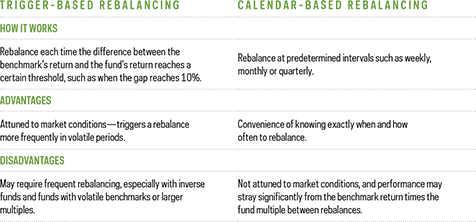Rebalancing Calculator
Rebalance a geared fund position
Just fill in the amount of your initial investment, the return of the index or benchmark since then, and your current investment value. The calculator automatically suggests a rebalance trade amount to help you realign your exposure.
$
Target $ Investment
This is the dollar value your account should be after you rebalance
$
Rebalancing Trade
About this Tool
Most leveraged and inverse funds, also called “geared” funds, aim to provide a multiple of the return of a benchmark for a single day, before fees and expenses. To maintain their investment objectives, geared funds rebalance their exposure to their underlying benchmarks each day. As a result of daily fund rebalancing, an investor holding a geared fund longer‑term is unlikely to continue to receive the fund’s multiple times the benchmark’s returns. As long as the fund is held, compounding can cause the investor’s exposure to the underlying benchmark to continue to deviate from the fund’s stated objective.
Investors using geared funds over periods longer than one day are encouraged to actively monitor their investments, as frequently as daily, and to consider a rebalancing strategy for their holdings.
What is rebalancing?
Rebalancing involves periodically adding to or trimming an investment in a fund to reduce the difference between the benchmark’s return and the fund’s return over time—sometimes called the "gap"—to help keep exposure in line with the fund’s stated objective. Rebalancing can buffer the negative effects of compounding during volatile periods, but it can also reduce the positive effects of compounding during trending periods. In addition, because rebalancing involves buying and selling shares, it may require additional cash and can result in transaction costs and tax consequences.
Establishing a rebalancing strategy
There are two common rebalancing strategies: trigger-based and calendar-based. No matter which rebalancing approach is used, investors should monitor their positions as frequently as daily.

Rebalancing an inverse fund position
-
STEP 1
Decide when to rebalance using a trigger- or calendar-based rebalancing strategy. -
STEP 2:
Calculate the gap between the benchmark's return and the fund's return. Benchmark Return (5%) – Fund Return (-10%) = Gap (15%) -
STEP 2:When it is time to rebalance, calculate how much to increase or decrease the position. Initial Value ($100) x (1 + Benchmark Return (0.05)) – Fund's Current Value ($90) = Rebalance Trade Amount ($15)
-
STEP 4
Add $15 to the current position of $90 to realign the dollar exposure to the ending index price of $105. Monitor and repeat if necessary.

Factors that affect rebalancing frequency
Before implementing a rebalancing strategy, investors should evaluate its potential benefits against likely transaction costs and tax consequences, as well as the possibility of sacrificing positive returns. When using any geared fund rebalancing strategy, monitor the position as frequently as daily, no matter how often you intend to rebalance. How often you may need to implement a rebalancing trade is influenced by the characteristics of the fund and the index as well as by market conditions.
- Fund Multiple: The higher the fund multiple (e.g., 3x versus 2x), the more frequently you will generally need to rebalance. In addition, an inverse fund requires more rebalancing compared to a corresponding leveraged fund (e.g., -2x versus 2x) because it moves in the opposite direction of the underlying index each day.
- Volatility:A g eared fund based on an index with higher volatility may require more frequent trades to rebalance than one based on an index with lower volatility.
- Percentage Trigger or I nterval:In a trigger-based rebalancing strategy, a larger trigger implies fewer rebalances over time. In a calendar-based rebalancing strategy, fewer intervals implies fewer rebalances over time. All other factors being equal, a percentage trigger of ±10% will require less rebalancing than one of ±5%, just as quarterly intervals will require less rebalancing than weekly. In both instances; however, the size of the trades may be larger.